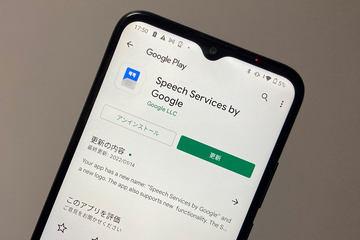why not? Google Assistant's interpretation function and Google Translate's conversation mode
"Google Pixel 6" and "Google Pixel 6 Pro", which are equipped with Google's own chipset, have faster on-device processing of machine learning and enable Japanese speech recognition without relying on the cloud. has become
The previous model "Google Pixel 5" was only compatible with English, but the recorder function that can record voice and convert it to text (transcription) is also compatible with Japanese. Among the writers, it has become a topic that it can be used for interviews.
The author also pays attention to the evolution of the interpretation function. I'm not good at English, but I don't want to study it, so I have the ambition to overcome the language barrier with the power of technology if possible. Previously, I wrote in this "Minna no Keitai" that I was betrayed by the real-time translation of Google's headphones "Google Pixel Buds", but I still have high hopes.
Related article[Everyone's mobile] I compared Google Pixel Buds with the first generation not yet released in Japan [Google Pixel 4]

On "Google Pixel 6" and "Google Pixel 6 Pro", the translation function of Google Assistant is fast and accurate, and bi-directional machine translation can be performed quite smoothly. I actually tried the translation function of Google Assistant on "Google Pixel 6 Pro" with a foreign friend, and my friend was also surprised by its speed and accuracy. The speed of speech recognition is so fast that if you cut off a word, it will be translated at that point, so you can't help but speak too fast. The time may finally come when technology can overcome language barriers! "It makes me want to dance."
The interpreter function is activated when you speak to Google Assistant like "interpret into English". When you speak in Japanese, it instantly recognizes your voice and converts it into text in real time. That is how it is translated into English and read aloud. Conversely, if you speak in English, the English will be converted into text this time, translated into Japanese and read aloud. In "automatic" mode, it recognizes whichever language you speak and translates it into the other's language. What is surprising is that the speed from speech recognition to translation and reading is quite fast. You can speak and understand without slowing down the conversation.
If you can operate this from headphones, wouldn't it be possible to have a natural conversation while speaking different languages? So I tried using "Google Pixel Buds A-Series" that can activate Google Assistant from headphones.
Put on the "Google Pixel Buds A-Series" and press and hold the outside of the headphones to activate the Google Assistant.
When I said "interpret into English", the conversation mode of the "Google Translate" app was activated instead of the Google Assistant's interpretation function. As mentioned above, the interpretation function of Google Assistant is quite speedy from speech recognition to translation and reading, but the conversation mode of the "Google Translate" application is a little different. As mentioned above, the interpreter function of Google Assistant can use the "automatic" mode, but the conversation mode of the "Google Translate" app cannot use automatic language recognition when using headphones. When speaking in Japanese, you need to press the button labeled "Japanese", and when speaking in English, press the button labeled "English". Also, the speed from speech recognition to translation and reading aloud feels a little slow. The synthesized Japanese voice is also a little harder to hear than the interpreter function that reads out with the Google Assistant's voice (well, this is also a synthesized voice).
I thought it would (look) smarter if I could use the Google Assistant's interpreting function without slowing down the conversation with headphones, but that doesn't seem to workIt's the same Google Translate function. , What is the difference between the Google Assistant and the "Google Translate" app? I wondered and tried to run offline, but Google Assistant's interpretation function can not be used in "automatic" mode, but if you select a language and speak it will be translated even offline, but the "Google Translate" app It didn't work offline. Apparently this is not yet processed on-device. In this experiment, it was also found that when offline, the Japanese reading of the Google Assistant's interpretation function will be the same synthesized voice as the "Google Translate" app.
I thought it would be even smarter if the conversation speed interpretation function could be used with headphones, but as far as I tried, the "Google Translate" app was launched from the "Google Pixel Buds A-Series", It didn't work. I think that the "Google Translate" app will be updated later, so I would like to wait for a while.